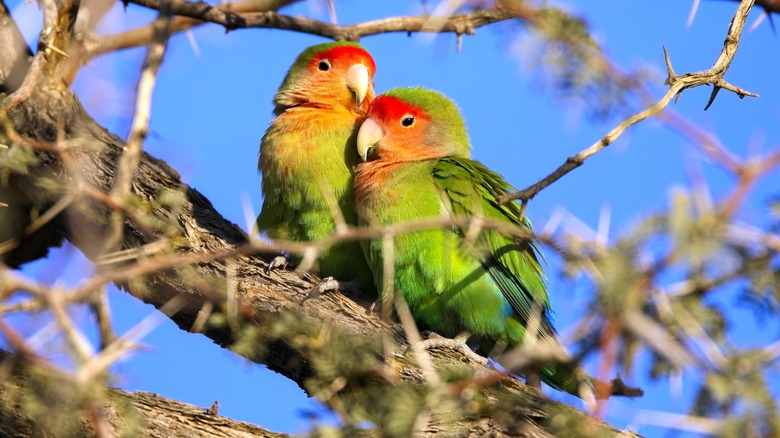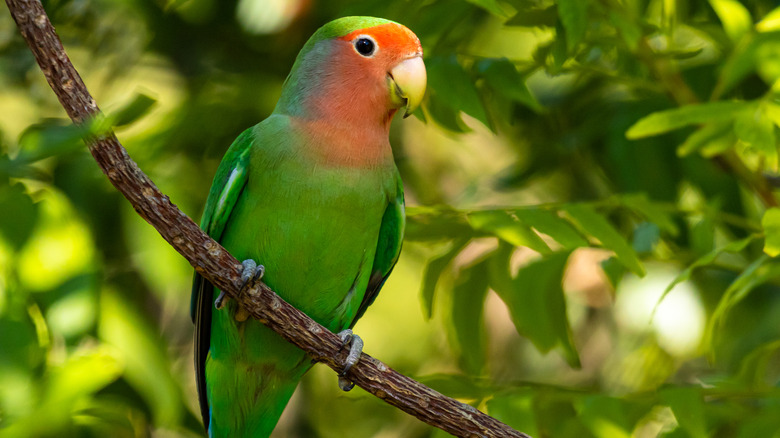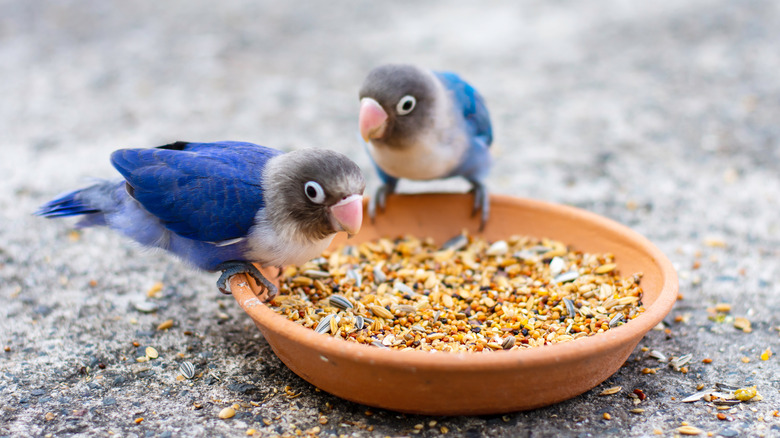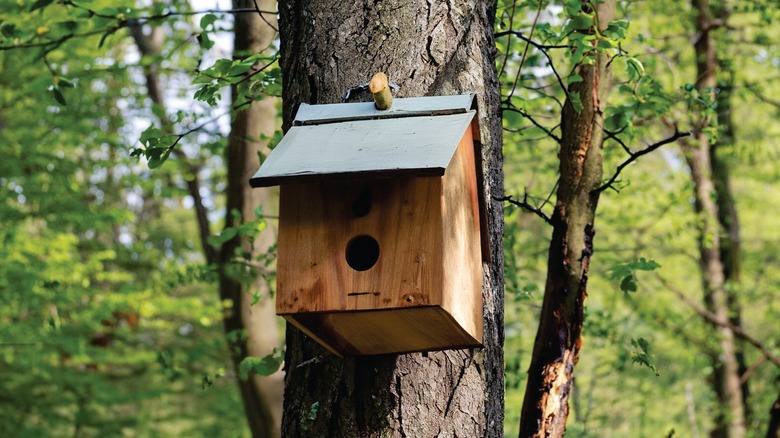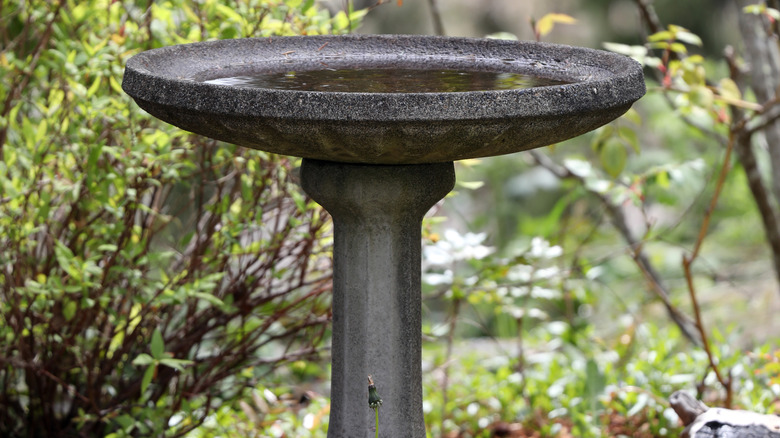Don't Make These Mistakes When Trying To Attract Lovebirds To Your Garden
There's something sweet and charming about lovebirds. Noted for being brightly colored and similar to parrots, these birds can be interesting to watch; they seem to be just as interested in you as you are in them. If you hope to see them in your garden, you'll need to create the right environment to attract these somewhat elusive creatures. Of course, you'll first have to live in an area where they are commonly found. These birds are native to southwestern portions of Africa. However, some populations are present in Arizona and other parts of the Southwest US, where they thrive in very warm temperatures throughout much of the year.
Their notably peach-colored faces and small size of about 6 inches make them beautiful birds to see in your yard. Their name comes from the fact that they create strong bonds in pairs, and they typically live in small flocks. With a few simple steps, you can create an environment where they will happily visit; just be sure to avoid these mistakes.
Don't plant the wrong flowers near your home
One of the first mistakes to avoid is adding too many non-native plants to your yard. They desire what they know, and that means a backyard filled with native flowers. They specifically are attracted to pollen and nectar flowers and will routinely seek out any plants that produce them. If you have a good source of flowering plants offering these must-have food sources, lovebirds are likely to call your yard home.
There are many flowers you can select for this. That includes easy-to-grow impatiens or petunias. You can also plant blueberry bushes and other fruit bushes (they enjoy most nuts and seeds, too). You can also attract them with hibiscus and morning glory vines.
A range of nectar plants thrive in the warmer temperatures of the Southwest. Other options include painted daisies, rush milkweed, and sunflower. Choosing plants that will support the birds throughout the year is essential. Evergreen trees, as well as most types of shrubs, are an important component of lovebird support. They will use these structures for shelter and to hide from predators. When you introduce more native plants that can provide year-round seeds and nuts, you are creating the ideal space for these cute birds to move in.
Don't forget to set up a source of food
While plants, as we've mentioned, are certainly an important part of supporting the needs of lovebirds, making it easy for them to find a food source can be just as important. There are a wide range of ways to supplement their food, the easiest of which is providing a well-stocked birdfeed or two located a safe distance from your home.
Bird feeders for lovebirds should contain what they know and love. Choose bird food blends that include millet, black-oil sunflower, and sunflower heads. They will do well with safflower seeds, too. These birds enjoy eating shelled peanuts and sunflowers but also enjoy fruit. When possible, supplement their diet to include papaya pieces or other types of dried fruit. Make sure they don't contain added sugar or flavorings to them. You can find bird food blends that offer a variety of nut, seed, and fruit combinations that are sure to attract lovebirds on a consistent basis.
These birds are small, so they can benefit from most types of bird feeders. However, cylinder feeders tend to be ideal, especially since you can put larger fruit-sized pieces of treats within them. Tube feeders are a bit more narrow and offer the benefit of discouraging larger birds from using them. The smaller perches on tube feeders are perfect for lovebirds. Make sure you keep the birdfeeder clean and sanitary since that can impact their overall desirability.
Don't overlook the value of providing lovebirds with shelters
Creating a natural habitat for your lovebirds is a must. It's a big mistake not thinking about shelters, though, for these birds. They enjoy places where they can hide and rest while also being protected from threats. The native trees and shrubs in your area, especially evergreens, will contribute to this. To encourage them to come towards your home, plant a row of shrubs or smaller evergreens along the edge of your property. This gives the birds enough distance from people but keeps them close to the food sources you've provided.
If your yard doesn't have any shade trees, consider installing a few birdhouses. These should be placed along the edge of the property away from busy traffic areas, whether that's where you spend time or the dogs play.
You can also use nesting boxes for lovebirds. Choose those that have good ventilation holes along the top and base to keep air moving through them easily. Nesting boxes for lovebirds don't need (and shouldn't have) a perch within them since this encourages other birds to use the box to peck at lovebirds. You can purchase a wide range of these nesting boxes from sources like Amazon or specialty organizations. Look for boxes that have a simple structure made of natural materials. Be sure to monitor these boxes over time. Squirrels and other pests may want to try to use them as a home, too.
Don't get too close
Lovebirds are very interesting birds because they seem to want to find out who you are and what you have to offer to them. Yet, you can't get too close. They are wild birds, and therefore, you shouldn't attempt to capture them, domesticate them, or even touch them. Doing so will discourage these birds from coming anywhere near you.
If you want to see these animals up close in the wild, one option is to install a birdfeeder with a motion-activated camera on it. Fill it with the seeds and other goodies that lovebirds love, and then watch from your app. There are a few other tips to consider to make sure these birds are welcomed into your yard. For example, install a birdbath close to where you've created a shelter for the birds. Keep the water clean and sanitary there, and you'll likely see these birds splashing from time to time. You can position your birdbath closer to your home as long as the birds feel safe using it (your dog barking isn't going to help!)
Also, avoid using any chemicals in your yard, including fertilizers for your grass. This is harmful to the birds and makes them seek out alternative places to call home. Remember, too, that these are small birds, and as a result, they're apprehensive. Give them time and patience with good consistency in having food available to spot lovebirds in your yard.
